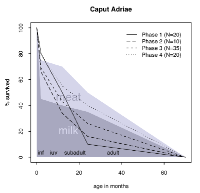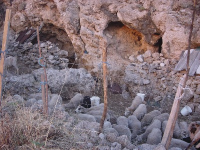Trajectories of Mesolithic and Neolithic landscapes of north Dinarides
PhD thesis at the Department of Archaeology, Faculty of Arts, University of Ljubljana
^top | about | thesis abstract | files

This work is licensed under a Creative Commons License.
Copyright Dimitrij Mlekuz 2005. Some rights reserved.
Last update: 26th August 2006.
About
Supplemental datasets and software for my PhD thesis Trajectories of Mesolithic and Neolithic landscapes of Dinaric Slovenia submitted to the Department of Archaeology, faculty of Arts, University of Ljubljana. Thesis advisor was Professor Mihael Budja. Thesis was accepted in July 2005.
Thesis abstract
The main goal of present study is reconstruction of trajectories of archaeological landscapes in the north Dinarides between 9000 and 3000 BC. Main questions that I tackle are: (i) how did innovations such as sheep, goats and pastoralism change social relations in the Mesolithic communities and (ii) how did these changes reflect and were reflected in the landscape? Approach is founded on theoretical premises that (i) changes of economic strategies could only be understood in the context of social relations and that (ii) landscape is medium and product of social life. First premise is implemented by employing the Marxian concept of ``mode of production'' in the study of past subsistence. Second premise is followed up with the use of the châine opératoire approach in the study of past activities in landscapes.
Discussing rich ethnographic and historical data on traditional subsistence strategies from the study area I take the position of ``radical defamilirization'' of Neolithic subsistence practices. In this perspectives modern practices should not be seen as fossil strategies from the deep past, but as dynamic responses to extremely complex natural, historical and economical processes. Structurally equivalent ethnographical analogies for Neolithic economies should therefore be sought elsewhere. I suggest two examples: the north American Navajo Indians and Cyclops from Homer's Odysseus.
The main body of the dissertation answers questions on scale and specialisation of hunting and pastoral economies in a long-term perspective, seasonality of practices in a landscape, patterns of exploitation of animal products and structure of settlement pattern.
Although sporadic finds of domestic sheep can be found in late Mesolithic contexts, specialised strategies of small stock management appear in early Neolithic. This change is also reflected in a radically different use of sites from early Neolithic onwards. Mesolithic sites were primary gatherings of people; with appearance of small stock they became animal stables.
 Neolithic/Eneolithic use of caves: layer of ash -- burnt animal dung from Mala Triglavca site (Karst, Slovenia).
Neolithic/Eneolithic use of caves: layer of ash -- burnt animal dung from Mala Triglavca site (Karst, Slovenia).
Generally small sample sizes of animal bones demonstrate low intensity of bone deposition, which can be modelled by consumption of only one household. Sites were seasonally occupied. Pattern of seasonal use of sites can be interpreted by two exclusive scenarios. However, both support idea that sites from the study area are part of complete seasonal cycle. In early and middle Neolithic domestic animals were exploited mainly for meat. Animal management strategies were not optimised and were geared towards satisfaction of immediate needs. Milk became important animal product in the late Neolithic/Eneolithic. This change in pattern of animal product exploitation is reflected also in a trend of diversification of animal management strategies. Remains of wild animals display pattern where only low-utility parts can be found on sites, whereas high utility animal parts were consumed elsewhere. Bones of domestic animals display inverse pattern. This may demonstrate complementary use of sites through seasonal cycle.
 Meat or milk: combined kill-off curves for ovicaprids from the Caput Adriae. Phase 0 - Mesolithic/Neolithic transition, Phase 1 -- Early/Middle Neolithic, Phase 3 -- Late Neolithic/Early Eneolithic and Phase 4 -- Eneolithic/Early Bronze age.
Meat or milk: combined kill-off curves for ovicaprids from the Caput Adriae. Phase 0 - Mesolithic/Neolithic transition, Phase 1 -- Early/Middle Neolithic, Phase 3 -- Late Neolithic/Early Eneolithic and Phase 4 -- Eneolithic/Early Bronze age.
The main conclusion is that transformation from hunting and gathering to pastoralism in the study area was much more than mere incorporation of domestic animals into Mesolithic societies. It was a deep structural transformation of societies and landscapes and not just an intensification of old strategies with new resources.
Files
Texts
Full text (in Slovenian, with English abstract). PDF file, 11.1 Mb. download
Mlekuz, D. 2005. The ethnography of the Cyclops: Neolithic pastoralists in the eastern Adriatic. Documenta Praehistorica 32: 15-51. PDF file, 6 Mb. download. supplemental data
Bibliography
Complete bibliography in the BibTex format. 716 bibliographic entries, 215 KB. download
Datasets
List of animal remains samples with data on NISP, richness, diversity and bibliographic references. Text file with comma separated fields, 4 KB. download
List of animal remains samples with species NISP information. Can be used for construction of background population for simulation of sample size on richness and diversity of animal remains assemblages. Text file with comma separated fields, 12 KB. download
Software
All software available here is released under General Public Licence.
Collection of Ruby scripts which can be used to simulate effect of sample size on richness and diversity of an animal remains assemblage. Gziped tar archive, 12 KB. download


